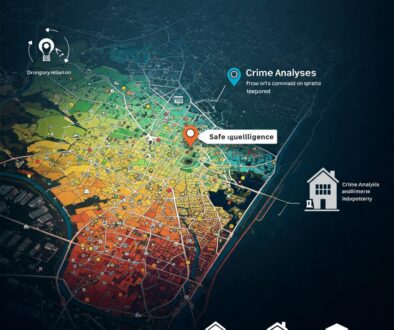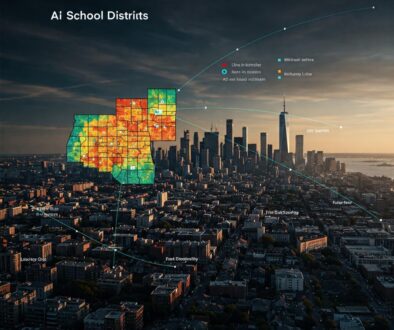The Impact of Nearby Amenities on Real Estate ROI: An AI Analysis
The influence of nearby amenities on real estate value and performance has long been recognized by investors and developers. Properties with convenient access to shopping, dining, parks, and other desirable facilities typically command premium prices and experience stronger appreciation compared to less well-situated alternatives. This relationship is so established that proximity to amenities has become a standard consideration in property valuation and marketing.
However, the traditional understanding of amenity impact tends to be superficial and generalized, relying on simple distance measurements or basic counts of nearby facilities. This approach misses the complex and nuanced nature of how different amenities affect property performance across various contexts, property types, and market segments.
In 2025, AI-powered geospatial intelligence platforms like Locas.dev are transforming amenity impact analysis, providing multidimensional assessment that helps investors make more sophisticated decisions about how specific amenity combinations will affect their real estate investments’ return on investment.
The Evolution of Amenity Analysis in Real Estate
Traditional Approach
Conventional assessment of amenity impact typically involves:
- Counting nearby businesses within certain distance rings
- Noting the presence of “desirable” amenities in listing descriptions
- Simple walking distance measurements to key facilities
- General references to neighborhood amenities in market materials
- Basic categorization of amenity types (retail, dining, etc.)
This approach has significant limitations:
- Oversimplified proximity metrics that miss accessibility nuances
- Limited quality differentiation between similar amenity types
- Minimal understanding of amenity interaction effects
- Poor recognition of demographic-amenity alignment
- Inadequate assessment of future amenity development
“Traditional amenity analysis treats all coffee shops or parks as essentially equivalent, and often misses how amenities work together to create neighborhood character,” explains urban economist Dr. Jennifer Lee. “In reality, the amenity impact on property performance involves complex interactions between specific business types, quality levels, accessibility patterns, and demographic preferences.”
How AI Transforms Amenity Impact Analysis
Modern geospatial intelligence platforms transform amenity-related property analysis through:
1. Amenity Quality and Character Assessment
Traditional Approach: Simple counting of amenity types without quality differentiation, treating all businesses in the same category as equivalent.
AI-Enhanced Approach: Sophisticated quality intelligence includes:
- Review-based quality assessment of individual businesses
- Brand positioning analysis of retail and service establishments
- Price point and target market evaluation
- Operating hours and accessibility patterns
- Longevity and stability prediction for individual businesses
Real-World Impact: “We were comparing two properties with seemingly similar amenity counts in their vicinity,” notes Michael Chen of Meridian Investments. “The AI analysis revealed that while both locations had multiple dining options, one area featured primarily high-quality independent restaurants with strong reviews and stable operations, while the other was dominated by lower-performing chain establishments with higher turnover. Properties near the quality-focused restaurant cluster commanded 17% higher rents and experienced 22% less vacancy—a performance difference completely missed by traditional amenity counting.”
2. Amenity Ecosystem Synergy Analysis
Traditional Approach: Evaluation of individual amenities in isolation, missing the powerful synergistic effects of complementary business combinations.
AI-Enhanced Approach: Detailed ecosystem intelligence includes:
- Complementary business pattern identification
- Amenity clustering effect quantification
- Cross-business customer flow analysis
- Vacancy impact on ecosystem integrity
- Anchor business dependence assessment
Real-World Impact: A retail investor used ecosystem synergy analysis to identify a location where the specific combination of businesses created a particularly strong amenity cluster despite a relatively modest amenity count. The platform detected a self-reinforcing ecosystem where a specialty grocery store, coffee shop, fitness studio, and home goods boutique created strong cross-shopping patterns and daypart coverage. Properties adjacent to this synergistic cluster outperformed comparable locations with actually higher raw amenity counts but less cohesive business combinations.
3. Demographic-Amenity Alignment Evaluation
Traditional Approach: General assumption that more amenities are always better, without considering how specific amenity types align with different demographic preferences.
AI-Enhanced Approach: Sophisticated alignment intelligence includes:
- Demographic preference mapping for amenity types
- Lifestyle segment amenity priority analysis
- Generational difference identification in amenity values
- Family structure impact on amenity utilization
- Income level alignment with amenity offerings
Real-World Impact: “The AI platform identified that our target neighborhood had an exceptional alignment between its specific amenity mix and the demographic composition of the area,” explains Sarah Williams of Urban Investment Partners. “The concentration of artisanal food businesses, boutique fitness options, and craft breweries perfectly matched the preferences of the area’s dominant millennial professional demographic. This alignment translated to a 28% premium in achievable rents compared to nearby areas with similar amenity counts but less demographic-specific offerings.”
4. Accessibility and Convenience Optimization
Traditional Approach: Simple straight-line distance measurement to amenities, missing the nuanced reality of actual accessibility and convenience.
AI-Enhanced Approach: Comprehensive accessibility intelligence includes:
- Actual route analysis rather than straight-line distance
- Multi-modal accessibility scoring across transportation types
- Time-of-day variation assessment for access convenience
- Psychological barriers identification affecting perceived access
- Last-mile connectivity evaluation for different user types
Real-World Impact: An apartment developer evaluated two potential sites with similar amenity proximity using traditional measurements. The AI-powered accessibility analysis revealed that while both sites had comparable straight-line distances to key amenities, one location benefited from significantly superior actual route quality, pedestrian infrastructure, and psychological comfort factors. Post-development, this property achieved 14% higher rents and 23% faster lease-up specifically attributed to the superior real-world amenity accessibility that wasn’t captured in simple distance metrics.
5. Amenity Evolution Prediction
Traditional Approach: Static assessment of current amenities without consideration of how the neighborhood offering might evolve over time.
AI-Enhanced Approach: Forward-looking amenity intelligence includes:
- Business formation pattern recognition for emerging districts
- Retail evolution stage identification in neighborhood development
- Pioneer business type prediction for transitioning areas
- Commercial vacancy trajectory analysis
- Amenity maturation curve modeling for developing neighborhoods
Real-World Impact: “The AI analysis identified our target area as being in the early ‘pioneer business’ phase of a retail evolution pattern seen in similar transitioning neighborhoods,” notes Robert Martinez of Horizon Development. “The platform predicted specific business categories likely to enter the area next based on hundreds of similar neighborhood trajectories. By developing a mixed-use project oriented toward these anticipated business types, we achieved 94% commercial occupancy within six months of completion, with the exact tenant mix closely matching the AI’s prediction.”
Case Study: The Westside Residential Portfolio
When Summit Investments was developing a residential acquisition strategy across multiple neighborhoods, they employed both traditional amenity assessment and AI-powered impact analysis:
Traditional Assessment:
- Simple counting of restaurants, shops, and services within 0.5 miles
- Basic amenity type categorization for each area
- Walking distance measurement to popular destinations
- Mention of key amenities in broker materials
- General classification of neighborhoods as “amenity-rich” or “limited”
AI-Enhanced Intelligence:
- Quality-adjusted amenity scoring revealing actual service value beyond raw counts
- Ecosystem synergy analysis identifying particularly effective business combinations
- Alignment assessment showing 73% variation in demographic-amenity match across areas
- True convenience mapping incorporating actual routes, barriers, and psychological factors
- Evolution prediction identifying three neighborhoods in early-stage amenity development
Based on this comprehensive intelligence, Summit:
- Targeted acquisitions in areas with high-quality amenity ecosystems rather than simply high amenity counts
- Identified properties where amenity alignment with demographics created premium potential
- Discovered emerging neighborhoods showing early signs of amenity ecosystem development
- Optimized property improvements to complement existing amenity strengths
- Developed marketing materials highlighting specific amenity advantages relevant to target renters
The result was a portfolio that outperformed market benchmarks by 21% in rent growth and 17% in occupancy by strategically leveraging amenity factors beyond simplistic proximity measures, with particularly strong performance in properties where emerging amenity patterns created value growth opportunities.
Key Amenity Factors Affecting Property ROI
Modern geospatial intelligence platforms analyze several critical dimensions to understand amenity impact on property performance:
1. Amenity Quality and Relevance Factors
- Business quality assessment beyond simple presence
- Brand positioning and target market alignment
- Customer review patterns and satisfaction levels
- Operating hours and accessibility timing
- Uniqueness and destination potential
2. Ecosystem and Synergy Elements
- Complementary business mixes creating district character
- Daypart coverage across business combinations
- Customer journey patterns between amenities
- Critical mass thresholds for different amenity types
- Anchor business identification and stability
3. Accessibility and Experience Dimensions
- Actual route quality beyond distance measurement
- Multi-modal access options for different user preferences
- Psychological comfort factors affecting perceived accessibility
- Visual connection and wayfinding clarity
- Integration quality between properties and amenities
4. Demographic Alignment Considerations
- Life stage preferences for different amenity types
- Income level matching with service price points
- Lifestyle segment prioritization of amenity categories
- Cultural relevance factors for diverse populations
- Family structure impact on amenity utilization
5. Future Evolution Indicators
- Pioneer business identification in emerging areas
- Commercial vacancy and turnover patterns
- Renovation and investment trends in existing businesses
- New license application monitoring for coming establishments
- Retail adaptation patterns to changing demographics
Implementing Amenity Intelligence in Your Investment Strategy
To leverage these advanced capabilities in your real estate investment approach:
1. Focus on Amenity Quality Over Quantity
Move beyond simple amenity counting:
- Evaluate the quality and character of specific businesses
- Consider customer experience and satisfaction indicators
- Assess the stability and longevity potential of key amenities
- Analyze target market alignment between amenities and your property
- Identify unique and destination amenities that drive area visits
2. Understand Amenity Ecosystem Dynamics
Recognize the importance of amenity combinations:
- Identify complementary business mixes that create synergy
- Evaluate customer flow patterns between different amenities
- Assess anchor business strength and potential stability issues
- Consider daypart coverage across the amenity ecosystem
- Analyze how vacancies might impact overall ecosystem integrity
3. Match Amenities to Target Demographics
Align investment strategy with demographic-amenity fit:
- Identify the specific amenity preferences of your target residents/tenants
- Assess how well local amenities match these demographic priorities
- Consider evolving demographic trends and future amenity needs
- Recognize how different amenity types impact different market segments
- Develop positioning strategies highlighting relevant amenity advantages
4. Evaluate True Accessibility Experience
Consider actual convenience beyond simple distance:
- Analyze real-world routes rather than straight-line distances
- Assess the quality of the journey to key amenities
- Consider psychological barriers that affect perceived accessibility
- Evaluate time-of-day variations in amenity access
- Identify opportunities to enhance connectivity to valuable amenities
5. Anticipate Amenity Evolution
Recognize that amenity landscapes change over time:
- Identify early indicators of emerging amenity districts
- Monitor business formation patterns that predict future development
- Recognize the typical evolution sequences in transitioning neighborhoods
- Consider how demographic shifts will impact amenity composition
- Position investments to benefit from anticipated amenity growth
The Future of Amenity Impact Intelligence
As AI and geospatial intelligence continue to evolve, several emerging capabilities promise even more sophisticated amenity impact analysis:
Real-Time Amenity Performance Monitoring
Future systems will track business performance indicators in real-time, providing continuous updates on the health and trajectory of key amenities affecting property value.
Experience Quality Quantification
Advanced platforms will increasingly quantify the experiential quality of amenities through sentiment analysis, social media patterns, and direct user feedback to assess their true impact beyond simple presence.
Personalized Amenity Value Mapping
AI will create resident-specific amenity value models, showing how different user profiles value various amenities differently and helping target market positioning accordingly.
Amenity Gap Opportunity Identification
Future intelligence will identify specific amenity gaps in neighborhoods, helping developers and investors recognize opportunities to introduce high-impact missing services.
Integrated Development-Amenity Optimization
Platforms will recommend specific property designs and features that maximize synergy with nearby amenities, creating integration strategies that enhance overall value.
Conclusion: From Amenity Proximity to Strategic Advantage
The relationship between amenities and property performance extends far beyond simple proximity. The evolution from basic amenity counting to sophisticated AI-powered amenity intelligence enables investors to:
- Target investments with precision based on quality-adjusted amenity profiles
- Identify value opportunities in emerging amenity districts
- Match properties to demographic-amenity alignment for maximum appeal
- Optimize positioning around specific amenity advantages
- Anticipate amenity evolution for long-term performance
In a market where lifestyle and convenience increasingly drive housing decisions, the competitive advantage belongs to investors who can incorporate sophisticated amenity intelligence into their real estate strategies.
Ready to transform your understanding of how amenities impact property ROI? Try Locas.dev today and experience the power of AI-driven amenity intelligence for your real estate investments.
This article was published on May 7, 2025, and reflects the current state of AI technology in amenity impact analysis for real estate. For the latest updates and features, visit Locas.dev.
Keywords: amenity impact property value, real estate nearby amenities, property ROI amenities, neighborhood amenity analysis, property value amenity correlation, proximity analysis real estate, AI amenity analysis



